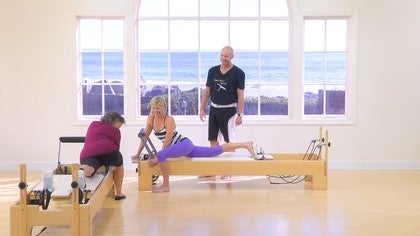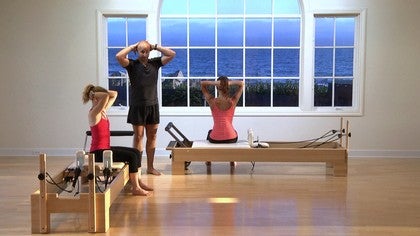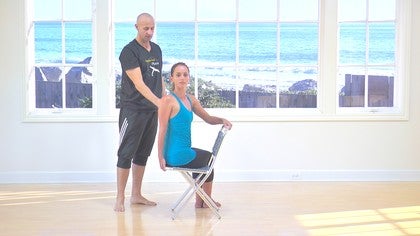Description
About This Video
Transcript
Read Full Transcript
This class that we're going to do is called hip openers. So, well we're going to try and do is stretch all of the major muscles of the hip joint so that the front anterior muscles, the lateral ones, the post area and the medial. So we're going to just, just focus on those muscle groups. Um, I think if your hips, uh, tie it makes performing a lot of the palladium material difficult because what happens when you're swinging your leg is that your spine won't stay in that solid neutral position. So doing these sorts of exercises will facilitate better performance of your [inaudible] work, but also on make your movements in daily life a little bit easier because you'll be able to be in from the hips rather than from the spine and just, um, it'll reduce the load on your pelvis and on your lower back if you're able to swing the leg more freely. So let's start off with a hip flexor stretch. Before we do that, I'm going to introduce our students. Candace, thanks for coming along. And Emily, who had hip surgery just yesterday, was it yesterday? No formats. Okay. So she's pretty good. She's recovering and we'll just, we'll see how you go.
Yeah. Yes. Okay. So let's start off with the hip flexes. There's lots of hip flexor muscles here. So, um, we're gonna let's start off with a, a sort of intermediate type stretch and then we can make it more difficult if you want. What I might do, Emily, is I'll start off and demonstrate for you the springs that you need for this one. Probably a just one red, so popper in spring and the spring tension, as I said in the previous class, it doesn't matter so much for this stretch, as long as you don't feel that it's too difficult to keep the carriage out. So, um, let's start with a read and we'll see. So the first position here is you're going to put your front foot level with this bolt, okay. And then push that back leg back and lowering your hips as much as you can.
Okay. That's your first position. Um, once you're in that position, I'll talk you through the wrist. Okay. So bend this knee. All right, let's do that. If you want some padding underneath your need, just let me know. So push the carriage out front foot under the inline with that bolt, and then lower your hips as much as you can. Good. Okay. Now with your arms, if you want, you don't have to keep them on the foot bar. You can put them next to you if you want. Um, whatever gives you the maximum support, the less weight that's bearing down through your hip joints, the more those muscles will be able to relax. Okay. So how's that feel you, you're getting a stretch yet? Yeah.
Whereabouts? Yeah. Same for you. Good. If Emily said that she was getting a stretch here, I'd say it's probably not a stretch. It's compression. So then we'd have to try something else. But you both feeling it in the front of the rear leg? Yes. Yeah. Okay. And how out of 10, how would you rate the stretch in terms of intensity?
Seven. Good. That's about what we want. So if it's too intense, the muscles won't relax. If it's below a certain threshold, you won't get much resolved. Okay. So let's do a little contraction. So we're going to activate the muscles that we're stretching in this case to activate the hip flexes. If you push this back forward, that lifted up, just push it down and the back knee down into the carriage is if you're going to swing that leg forward. So of course, yeah. So push down for one, two, three, four, five. Take a breath in. Now to restretch lowly, hips further, it doesn't mean necessarily moving the carriage out, it's more about just lowering those hips. How's there Emily?
Candace has a more good, so let's hold that and then I'll show you one more variation or two more. The first one is without lifting your hips, try and tighten your quads and just lift the knee cap out of the carrier. Good. So you should be out a slide, a little bit of thinker, a bit of paper under there. How's that field? More intense. Yeah. Good. So once you've got the knee off, just lowly hips again as much as you can. So you're doing some work with the quads of the back leg. You feel that, but the stretch should be a bit more intense.
Good. Now let's, let's try one more variation where we move the stretch more to the outside of the hip. So rotate the hip that you're stretching. So wards the springs more and keep it straight. Keep that knee lifted. Yeah. Is that okay? Sorry. Can assault. I'll show you. You've got the knee lifted. Try and lower your hips and then rotate them more that way.
Can you feel how, how that moves the stretch more to the outside? Yeah, there's a little muscle there that flexes the hip and it's often very tight. So that's what we're trying to focus on you, Emily, you're doing well considering you. You just got off the operating table yesterday.
Okay. It's just the position that her joint is most comfortable in. It won't really affect the stretch. Okay, so when we do the contraction here, I didn't explain to you before we, you don't need to use too much force about say 50% of your maximum. Okay, so let's do that now. So push this foot and this knee down as if you're pushing it down into the floor. So one, two, three, four, five stop. Take a breath in and then it's pretty, they're low. Your hips to raise stretch.
Let's say this time can is if you can do this as well, just stay where you are, but through all the abdominals innovate. And imagine you're doing just a tiny posterior tilt. Does that make the spreadsheet it stronger as well? Now hauling all of that, let's see if you can lift that back knee up as well. Just a tiny lift. Don't lift the hip scan, just the a.
That's it. That's better. So ideally your size, still in contact with the carriage, but generic cafes and so you've just taught in the quadriceps. A little grew in there. Let's try rotating that hip around. And as you do that, Emily, try and still keep the back leg straight.
Okay. Just hold a little bit longer. After we do the contraction, we usually try and hold the race stretch for 10 to 15 deep breads, which is about a minute and even more if you have time. Okay. All right. Let's come out of the stretch slowly and
So I'll demonstrate the stretch. I'm just gonna use one of these to go onto your knee. So here, then one day on here and the other one here. And then just carefully without any speed, just push the carriage out slowly until you start to feel a stretch on your inner thighs.
I'll take off that red spring. So you've got just a blue one. If that feels like it's going to slide out too much, tell me and we'll put another spring on. Good. So you can see your, that's good position Ganas. The knee is in line with the hip and then slowly just move the carriage out until you start to feel a stretch on the inner thighs. You both feeling there?
Yeah, that Emily, any stretch. I'm a bit reluctant to push you too much because, because of your hip operation, but are you feeling any stretch there now? Yeah. Okay. Remember we're only stretching the short adapters here. The long ones that cross the ne Y P stretch because we've got the knee bend. Okay, so let's do a little contraction. So without letting the carriage move.
So if you put your hand kind of yeah, just to prevent the carriage moving. Yep. Try and pull your knees together. So one, two, three, four, five, take a breath in and then as you breathe out, see if you can re stretch and just push the carriage out a little more.
Now we can vary this stretch or the effects of this stretch by leaning your hips backwards. Just be careful and laying your bottom backwards.
Are you both feeling what I'm talking about when you twist to the left? You feeling more in the right? Yeah. [inaudible] you'll find that you have imbalances from one side to the other. Okay, let's come back to the middle now. Slowly bring the carriage in. Cool. Now you know why it's called the squashed frog. You can, you can hop up carefully and I'm going to demonstrate, well, let's do one more adductor stretch because as I said, we've only really stretched there that some of the short ones this time we're going to stretch the longer ones that crossed the knee. Okay? If I do it on this reformer here, are you able to see me okay there? Yeah. Okay. Candace, if you come over here, I'll show you. So we've got a blue spring.
We're going to push out like this and support yourself on your arms. Push out till you start to feel a stretch in this leg and then bend the stance leg this way to lower yourself into it. Okay, so there's your first position. After that, we're going to try some variations where we go forward and back. We're going to turn this way and then we're also going to hold the carriage still and we're going to try turning the foot externally, rotating it, then doing the same leaning back and then turning towards the leg as well because that'll run the stretch through all of the muscles that wrap around the inside and in the back of the leg. Okay, so let's try that. What spring have you got? Just the blue. Yeah, that's good. So pop one foot up on in front of the shoulder is slightly push out. Lean across carefully. Good. And just push yourself out too.
You start to feel a stretch in this leg. Mosley and then lower yourself. Candice, by bending your left knee guys, slowly. Good. You both feeling a stretch. Good. So use your arms to support yourself as much as you can. Even if you have to put them on the floor, that's okay.
As long as you feel supported and that your white is not bare being uh, what's the word I'm looking for? 70 it to all of your body weight is not going down through the hips. If you can support yourself with your arms, it'll be more effective.
Push it down into the carriage. So down that wise I, one, two, three, four, five, take a breath in and relax. Good. So Emily knew what to do to restretch. She moved the carriage out a bit and lowered her hips. Has that canvas. That's okay. Now let's do a few variations. So very carefully.
Just lean your bottom backwards.
That's nice. Now let's come back to the middle. Keep the carriage out if you can. So hold the carriage still. And let's say if you can do what I did before, which was yeah, to turn leg out, you okay there? Make sure you do that slowly. If possible, try and visualize the movement before you make it. Then you'll know what you're doing. You won't hurt yourself. Okay, now let's try leaning your bottom backwards and pointing those bottom burns up.
Good. How's that? Does that feel different with your leg? Turned out?
Don't push it too far, Candace. That's fine. How's that, Emily? Does that feel different? More hamstring. Good. Let's come back to the middle. Come out of it slowly. This, I know this. This leg works hard. Yeah, that's why I'm saying use your arms as much as you can.
Otherwise it just becomes very difficult to hold. It was. Let's do the other side. Slowly push the carriage out, lean across good, and then carefully just bend this knee and at the same time that carriage will slide out. Good. So low yourself again, just to where you can comfortably hold. So the main stretch at the moment should be on the inner thigh of the leg that's on the carriage. You may get a stretch on the other leg as well. Okay, let's do a contraction.
So tighten the quadriceps a little bit here so that the Ne is supported. Then push the leg down into the carried. So one, two, remember you don't need to use too much force three, four, five. Take a breath in. Then as you breathe out, low yourself a little more good. Support yourself with your arms. You okay there? Canvas? Yeah, you've got a few differences. Just what you don't get your hair caught in the springs there. That's what happened to mine.
I had long hair before I did this stretch. Now let's try leaning your bottom backwards a little. So away from the carriage. Yep. Right now we'll come forward a little and then you can turn away from the straight leg. So towards me. Yeah, slow. Just carefully. It doesn't have to be much careness just a little bit. Whenever you're doing these exercises, this slightest movement can change the stretch and make it very intense.
So I make sure it's very slow and very minimal. Okay. Let's come back to the middle and then let's try doing the last part where we turn this leg out. So we're going to hold the carriage still with that hand externally rotate [inaudible] yeah. And then again, it's up to you how far you want to go. Just pain this day and lower yourself if this leg finding it a bit hard. Yeah. Good. Now try and point your bottom up. So it's a slide tilt of the pelvis forwards.
And let's do the last part now where we turn towards the leg, if he can kinda see if it's too much. You don't have to.
So now we've done, we've done the hip, the hip muscles at the front. We've done the middle. Now we're going to do some at the back. So they, we've got the hamstrings and some of the adductors and the glutes. Okay. So I might just demonstrate there. Let's put the bar just this size. So on the bottom one, and I think we need probably a red spring. Am I going to start with your foot like this?
So foot in line with your bottom bone and your chest on your leg. Okay, so we're not trying to do this, we're trying to keep the chest on the leg and just open out this angle until you feel a stretch under here. Okay. And my back leg is, is not really doing anything much. It's just holding the carriage out. Okay? Again, with your hands, you can use your hands to support yourself. All right, let's do that. And then we'll work from there. I had a red spring, so we might change that. Yeah. And the lowest one and one red. Okay. So just pick a leg. So yeah.
Emily, move across a bit. So this Ford is in front of this shoulder is, yeah, lift the other foot and put it on the bar. Good. How's that? Okay, so let's slowly push the carriage out until you feel the straits. I'm to here Emily trying to keep the knee a bit bent and KP chest on the leg. How's that? So Candace, you're not going to be moving back and forth. You just push out until you feel the stretch. And then you hold with the stretch coming from [inaudible]. Is it the underneath of the front leg here?
Yeah, that's what, that's what we're trying to stretch you. We're thinking of the hip flexes. Yeah, it'll be, yeah. Well it often, you will. Um, you'll feel in the hip flexor as well. But let's focus on the front leg for the moment. Now let's do a contraction. So push this front foot down. One, two, three, four, five.
Take a breath in and then as you breathe out, try and move the carriage a bit more. That's good. Emily, just rotate that he per around. Good. All right, so we're trying not to let this back leg come back into flex position. We're trying to keep that back leg back. If you can.
Emily, do you, do you prefer your hands there or here?
Okay, let's bring the carriage in.
It's essentially the same stretch except that you're, you're standing next to the reformer. So it's like this. So lower yourself as much as you can. And then again, we're trying to open out the angle here this way.
Now come back in and we can, as you bend the knee, now you keep down and you trying to open out this angle, like keeping yourself as low as possible.
So opening out the angle, the front. Good. Try and hold still. The more that you move around, the more that you start to wake up these muscles again. So we want them to be as still and relaxed as we can. See if you can think about the sensations coming from the area that you're stretching and see if they changing or if the intensity is the same or if it comes in waves.
And there might be a point where you find that you can relax and go a bit further. Okay, let's bring the carriage in. Good. And you okay? Still in one piece. All right, let's do one more glute stretch. So I might come around there and demonstrate.
So we're going to start like this. Um, so just recapping with done the hip flexes, the adductors, the hamstrings. Now we're just going to do one more for the glutes. Okay. So what you do here is sit, put your foot on the headrest and sit this way. Okay. So you need to sit back a bit. So this legs not bumping into the the carriage. Just sit back, put your weight onto this leg, and then so your knee is roughly in line with the naval. Okay.
Then we're going to try and rotate this hip. This is the critical path that this hip comes forward. Then we start laying forward. Okay? All right. Eventually what we're gonna try and do is get the arm pit over the knee like this. Okay. And then this hand pushing that way to help us to rotate.
Okay, so let's, let's just see first the springs are not important. As long as the carriage is stable, I'll give you one more sprain. Okay? So put your foot, Emily. Let's stay with stay seated where you are, but see, we want to try and line up the knee with the navel. That's it. So just take it across the tiny bit more. Good. That's good, Candice.
Now there's your starting position. Now the first thing is to bring that hip around. How's that? Okay. You can usually feel how much give there is in the muscle. Emily. How's that feel?
It's enough to start with. Just, you don't need to go into that second position just yet. Just hold that first one. Let yourself relax. Take a few deep breaths, see if you can let those muscles just go floppy. You don't want to hurry yourself with any of the stretches. How long do you think you were doing each position? A minute.
Do you think we should be a minute? Is the minimum. Really? Yeah. Most of the research will show that if it's less than there, that's really just a transient alteration and by the next day it's back to where it was like straight or the back leg can. You can relax it for now. Yeah. Okay. Let's do a contraction. I pushed your foot down. The one that, the one that's on the carriage, so push that down. One, two, three, four, five. Take a breath in. Now depending on where you are, how to restraints can be just a matter of right tightening the hip.
That might be enough for you. If it's not, the next stage would be to try and get this armpit over the Ne. Yeah. And if I lift the bar up a little, you'll be able to push into that one to assist with your rotation. How's that? How's that canvas? You've just got to make sure if you're doing this at high end that the rotation is not just three a thorax, but it's actually a pelvis.
So you'll see when I push on your hip the difference. You tell me when to stop. Oh, oh. Haven't started. Say the difference between turning from here and turning from, you know.
Do you want to swap so that you can both see Emily? Good. So I remember the sit with the foot on the shoulder, wrist on the head rest. I mean, yeah, just come back a bit Ken as that's right. That way you've got a bit of space here between your leg and the reformer. I'm going to put one more spring on so you don't slide away. Good. Now let's see if you can bring that back, the other hip around to bring yourself into the stretch.
Can you lower that leg a bit as well? Yeah, just let it relax. That's it. So that the hips here are level horizontally. How's that feel? Cod Time? Yeah. Okay. Let's contract. So push your foot down. So one not too hard.
Two, three, four, five big breath in res stretch can be for you, Candace. Probably just bringing the hip around further. Emily, for you, it might be getting the arm peed over and rotating further. Is that okay? If somebody is pressing on you, you've got to be careful and make sure that you tell them when it's enough. Is that strong enough for you, Candace? How is that? Do you need me to push or you know? Okay. Let's just come out of the stretch carefully and you're done. Thanks for participating.
Feel the Length: Innovations in Pilates
Comments
So glad you enjoyed it. Please send some photos to our Facebook page!
You need to be a subscriber to post a comment.
Please Log In or Create an Account to start your free trial.
























